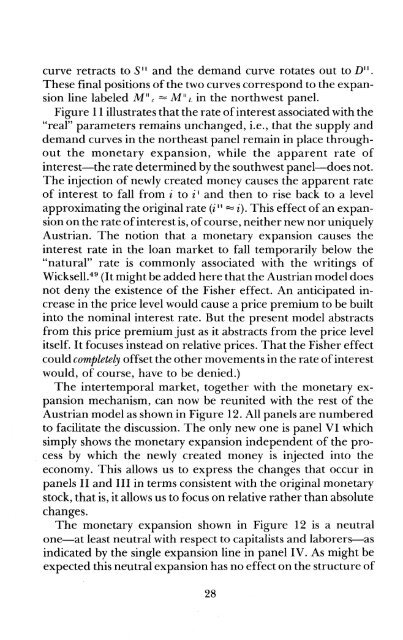Austrian Macroeconomics - Ludwig von Mises Institute
Austrian Macroeconomics - Ludwig von Mises Institute
Austrian Macroeconomics - Ludwig von Mises Institute
You also want an ePaper? Increase the reach of your titles
YUMPU automatically turns print PDFs into web optimized ePapers that Google loves.
curve retracts to SII. and the demand curve rotates out to D " .<br />
These final positions ofthe two curves correspond to the expansion<br />
line labeled Mile::::::: Mil L in the northwest panel.<br />
Figure 11 illustrates that the rate ofinterest associated with the<br />
"real" parameters remains unchanged, i.e., that the supply and<br />
demand curves in the northeast panel remain in place throughout<br />
the monetary expansion, while the apparent rate of<br />
interest-the rate determined by the southwest panel-does not.<br />
The injection of newly created money causes the apparent rate<br />
of interest to fall from i to i I and then to rise back to a level<br />
approximating the original rate (iii ::::::: i). This effect ofan expansion<br />
on the rate ofinterest is, ofcourse, neither new nor uniquely<br />
<strong>Austrian</strong>. The notion that a monetary expansion causes the<br />
interest rate in the loan market to fall temporarily below the<br />
"natural" rate is commonly associated with the writings of<br />
Wicksell. 49 (It might be added here that the <strong>Austrian</strong> model does<br />
not deny the existence of the Fisher effect. An anticipated increase<br />
in the price level would cause a price premium to be built<br />
into the nominal interest rate. But the present model abstracts<br />
from this price premium just as it abstracts from the price level<br />
itself. It focuses instead on relative prices. That the Fisher effect<br />
could completely offset the other movements in the rate ofinterest<br />
would, of course, have to be denied.)<br />
The intertemporal market, together with the monetary expansion<br />
mechanism, can now be reunited with the rest of the<br />
<strong>Austrian</strong> model as shown in Figure 12. All panels are numbered<br />
to facilitate the discussion. The only new one is panel VI which<br />
simply shows the monetary expansion independent of the process<br />
by which the newly created money is injected into the<br />
economy. This allows us to express the changes that occur in<br />
panels II and III in terms consistent with the original monetary<br />
stock, that is, it allows us to focus on relative rather than absolute<br />
changes.<br />
The monetary expansion shown in Figure 12 is a neutral<br />
one-at least neutral with respect to capitalists and laborers-as<br />
indicated by the single expansion line in panel IV. As might be<br />
expected this neutral expansion has no effect on the structure of<br />
28

















